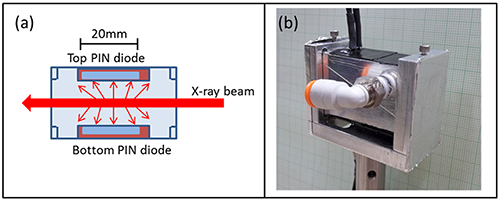X-RAY RUNS: Apply for Beamtime
2017 Nov 1 - Dec 21
2018 Feb 7 - Apr 3
2018 Proposal/BTR deadline: 12/1/17
2018 Apr 11 - Jun 4
2018 Proposal/BTR deadline: 2/1/18
We have developed a device that combines two functionalities in a compact assembly to measure simultaneously the X-ray beam position and intensity. In a recent work, Masayo Suzuki et. al.1 have reported the development of a high-flux X-ray monitor based upon the scintillation of Ar gas as X-rays pass through it. Unlike ion chambers, where the temporal response is limited by the drift velocity of charged particles in gaseous media, it is possible for Ar-scintillation monitors to yield time resolution better than 50 ns.
At CHESS, we have created a device that uses the same principle as the one mentioned above with the added capability of measuring X-ray beam position, in addition to flux.

Figure 1: (a): The cross-section diagram of the compact Ar-scintillation monitor. (b): Photograph of the actual device.
As shown in the sketch in Figure 1a, The CHESS XBPM/Flux monitor consists of an enclosed vessel with two PIN diodes mounted on the top and bottom of the device facing toward each other. As the X-ray beam enters the device through an opaque foil (Kapton, 6 µm thick), photo-current is generated as a result of the gas scintillation. The photocurrent from the two PIN diodes are separately amplified. While the position signal is derived from the difference-over-sum (D/S) of the top and bottom signals, the beam intensity is monitored as the sum of the top and bottom photo currents.
The device was tested at two experimental stations at CHESS: at the F3 bending-magnet beam line and at A2 beam line where X-rays come from a Wiggler source.
The X-ray beam was delivered in both experimental stations via Si (111) double-crystal monochromators. At F3 station, the flux of 17 keV X rays delivered though a 1x1 mm slit was 1.2•109 ph/s. At A2 station, the flux of 59.7 keV X rays though a 1x1 mm slit was 2.2•1010 ph/s.
Figure 2: Linear dependence between the ion chamber and the Ar-scintillation monitor responses as X-ray flux intensity was varied by opening a horizontal slit.
Figure 2 demonstrates that the sum signal from the top and bottom PIN diodes are linear with the flux, as measured by an ion chamber placed downstream of the Ar-scintillation monitor. In this experiment the X-ray flux was varied over two orders of magnitude by gradually opening the horizontal beam-defining slit upstream of the Ar-scintillation monitor.
Figure 3 we demonstrate the linearity of the position response of the Ar-scintillation monitor. The Ar-scintillation monitor was mounted on a motor-controlled Z-jack and data was collected while the device was translated vertically in 100 µm steps. In Figure 3, the top and bottom signals as well as the positions derived with the D/S method are shown as a function of Z-jack position. The noise level in the steady part of the position trace indicated that the precision of the position measurement was about ~1.9 µm. As seen in Figure 4, these measurements show that the device works with an excellent linearity response over a vertical beam motion range as large as 2 mm.
Figure 3: Position sensitivity of the Ar-scintillation monitor. In blue and red the top and bottom diode responses are shown; the beam position derived from the difference-over-sum is shown in black. The full span of the vertical motion was 2 mm.
Figure 4: Demonstration of linearity of the difference-over-sum response of the Ay-scintillation monitor with the vertical motion of the device.
For more details of this new device can be found in a paper by Revesz et. al.2
References:
[1] Masayo Suzuki, Hidenori Toyokawa, and Katsuya Hirota, "High Flux X-ray Beam Intensity Monitor Based upon Rare Gas Scintillation," AIP Conf. Proc. 705, pp. 580-583, Eighth International Conference on Synchrotron Radiation Instrumentation 25-29 August 2003, San Francisco, California (USA).
[2] Peter Revesz, Jacob Ruff, Darren Dale and Thomas Krawczyk: "Compact integrated X-ray intensity and beam position monitor based on rare gas scintillation," Rev. Sci. Instrum. 84, 053109 (2013); http://dx.doi.org/10.1063/1.4807698.
Submitted by: Peter Revesz, Jacob Ruff, and Darren Dale
CHESS, Cornell University
02/03/2014
